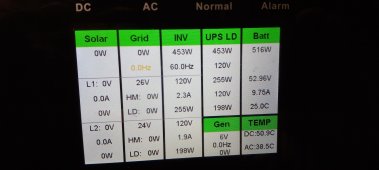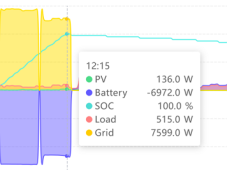6
629658
Guest
Robby is correct and another point must be made setting your SOC at any level will have absolutely ZERO effect on your grid usage. You do not have enough storage or panels I suspect to do what you want to do.
When your home needs power it has 3 choices Grid, PV, or stored power. The Sol Ark can’t manufacture electricity. You’re running your batteries so low you have no buffer at all. Once your batteries get to a certain point the Sol Ark is going to charge them no matter what and from wherever it finds the power to do that. So if you want no grid power used you are going to have to maintain a higher SOC in your batteries so you quit triggering the Sol Ark to raise the SOC. If you do not have adequate PV production to do this then it is grid or gen power for you. Your home loads are the rate limiting factor. If you use 60kWh then you must find a supply for 60kWh either grid, gen, or PV. Running your SOC down to zero will not replace the 60 kWh you used. In an off grid situation you must have more storage than grid tied systems. You must account for winters and cloudy short days. Days and days of low PV production or the Sol Ark will without you control try to maintain your batteries at a decent SOC. I was told by Sol Ark that if the Sol Ark sees grid power it will attempt to maintain a 40% SOC no matter what. In a grid out or off grid situation the Sol Ark will allow a much lower SOC. No sure how accurate that is but I work my batteries in a 40-100% power range and have zero issues. Your routinely working in the 5-20% range which is not good for you or your batteries but that’s what you want to do. I think you are going to continue to be very unhappy with your system until you decide to take some of the advice given.
You came here complaining about a Sol Ark inverter problem. Robby and I have given you our recommendations. However you keep blaming the equipment when your issues are completely settings related. Change the settings!! Not so sure why you’re so hell bent on keeping the settings what you have. I have given you mine and Robby will give you his. We both have zero issues. Maybe it’s time to set yours up like ours and see if it works before continuing to blame the equipment.
One final point, running your batteries in the basement all the time is definitely going to shorten their cycle life.
My final recommendation is add more storage so you’re not cycling your batteries so often and raise your min SOC. Try to hit 100% SOC once a day either from Grid or PV. Pick a profile either home or load and use similar settings as someone who has a trouble free Sol Ark. Until you do this you are going to be unhappy.
When your home needs power it has 3 choices Grid, PV, or stored power. The Sol Ark can’t manufacture electricity. You’re running your batteries so low you have no buffer at all. Once your batteries get to a certain point the Sol Ark is going to charge them no matter what and from wherever it finds the power to do that. So if you want no grid power used you are going to have to maintain a higher SOC in your batteries so you quit triggering the Sol Ark to raise the SOC. If you do not have adequate PV production to do this then it is grid or gen power for you. Your home loads are the rate limiting factor. If you use 60kWh then you must find a supply for 60kWh either grid, gen, or PV. Running your SOC down to zero will not replace the 60 kWh you used. In an off grid situation you must have more storage than grid tied systems. You must account for winters and cloudy short days. Days and days of low PV production or the Sol Ark will without you control try to maintain your batteries at a decent SOC. I was told by Sol Ark that if the Sol Ark sees grid power it will attempt to maintain a 40% SOC no matter what. In a grid out or off grid situation the Sol Ark will allow a much lower SOC. No sure how accurate that is but I work my batteries in a 40-100% power range and have zero issues. Your routinely working in the 5-20% range which is not good for you or your batteries but that’s what you want to do. I think you are going to continue to be very unhappy with your system until you decide to take some of the advice given.
You came here complaining about a Sol Ark inverter problem. Robby and I have given you our recommendations. However you keep blaming the equipment when your issues are completely settings related. Change the settings!! Not so sure why you’re so hell bent on keeping the settings what you have. I have given you mine and Robby will give you his. We both have zero issues. Maybe it’s time to set yours up like ours and see if it works before continuing to blame the equipment.
One final point, running your batteries in the basement all the time is definitely going to shorten their cycle life.
My final recommendation is add more storage so you’re not cycling your batteries so often and raise your min SOC. Try to hit 100% SOC once a day either from Grid or PV. Pick a profile either home or load and use similar settings as someone who has a trouble free Sol Ark. Until you do this you are going to be unhappy.
Last edited by a moderator:






